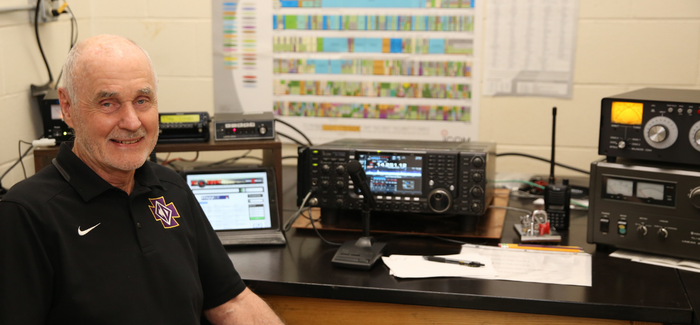CDH is Back on the Airwaves
September 21, 2022

“This is WØCDH, over.” For the first time in more than fifty years, calls are going out from a radio tower on campus.
For about seven years in the late 1950s and early 1960s, Cretin was home to a thriving Ham Radio Club. It was during those years that John Bellows ’62 got his introduction to amateur radio.
“There was a certain technical magic to it,” he said. “At that point, the idea that you could sit in front of a piece of equipment that you either built or modified and talk to people around the world was just fascinating to me.”
Alongside his career in law, Bellows has stayed involved in amateur radio through the decades following his graduation. He has traveled to 22 countries as a ham radio operator, and been involved in national and international organizations.
Brother Robert Walsh first got involved in radio when he was doing missionary work in Central America, and radio was the most efficient way to communicate with his mother back in St. Paul. Last summer, he was hoping to install a radio tower on the roof of the Brothers’ Residence, but learned he wouldn’t be able to due to structural reasons. The tower was installed on the roof of Frey Hall, which resulted in the perfect opportunity to get students involved. Walsh reached out to Bellows — who had examined him for his radio license decades earlier — and to the St. Paul Radio Club to help establish the group.
After a lifetime of enjoying the “mind expanding experience” of radio, Bellows was eager to share the opportunity with a new generation, and happened to have a connection with a source of donated equipment.
When Bellows and Walsh were young, cell phones did not exist and long-distance calls were prohibitively expensive; radio provided a unique opportunity to connect with people far away.
“I remember speaking with a ham in Australia, basically 11,000 miles away,” said Bellows. “It just seemed unbelievable. At a time when long distance telephone calls were charged by the minute and a minute to Australia was probably going to be $3 or $4!”
While today’s students have grown up in a world of instant digital connection, a group of students were still immediately interested in joining the club and experiencing this technology.
“I always had an interest in science and engineering,” said Ream Hashel ’23, a student leader in the club. “I thought joining this club would further my education, plus it’s been fun to meet people on other continents and have a conversation with them.”
Students in the club learn Morse code, the phonetic alphabet (Alpha, Bravo, Charlie…), and the technical aspects of working a ham radio. They can participate in competitions, and will have important skills to volunteer in times of natural disaster or for public events. The skills and relationships students develop as a ham radio operator can serve them well, even in a world dominated by computers and cell phones.
Students interested in joining should email Brother Robert Walsh. Walsh would also appreciate hearing from any alumni who are ham radio operators.

